How to Make Durian Chips? 8 Easy Steps!
Making durian chips is a delightful way to enjoy the ‘King of Fruits’ in a crispy form.
To create these chips, select ripe but firm durians, peel and slice them thinly, then dry the slices before baking or frying to perfection. Season to taste, and store properly to preserve freshness and flavor.
Here are some quick steps:
These steps will help you create a snack that captures the essence of durian in a crunchy and enjoyable form.
Enjoy the unique taste of durian in a new way by making your very own durian chips at home.
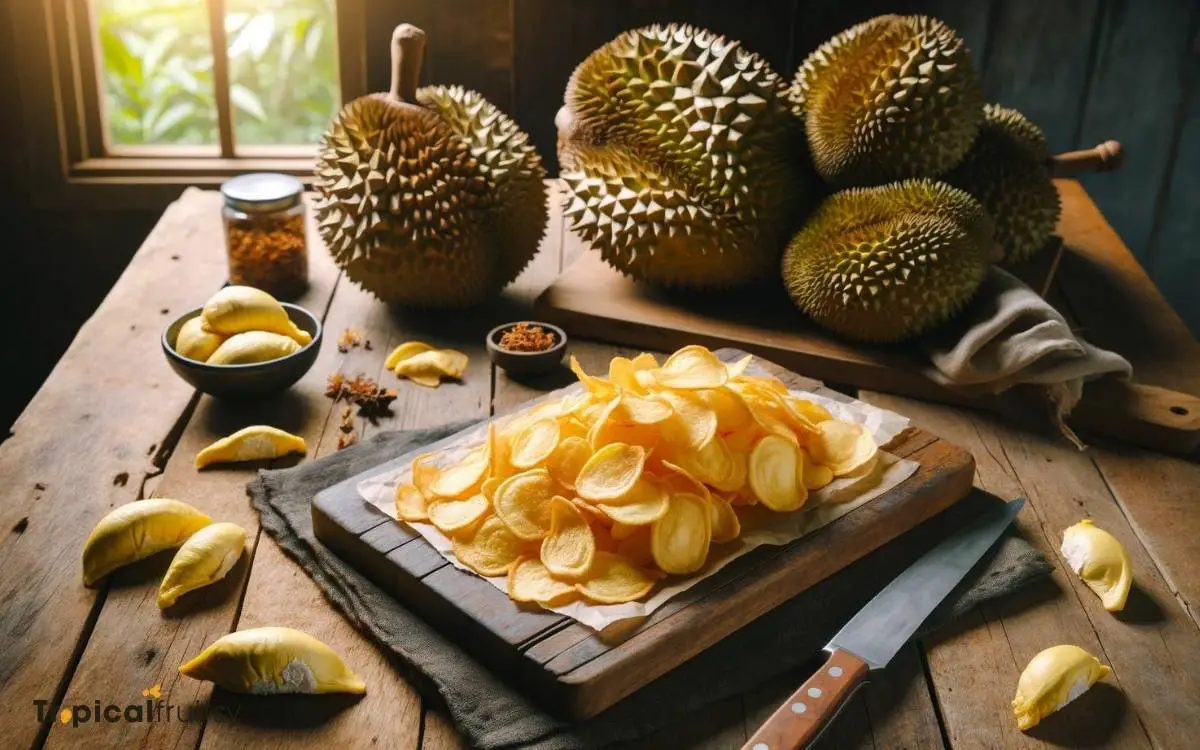
Key Takeaway
Step 1: Selecting the Perfect Durian
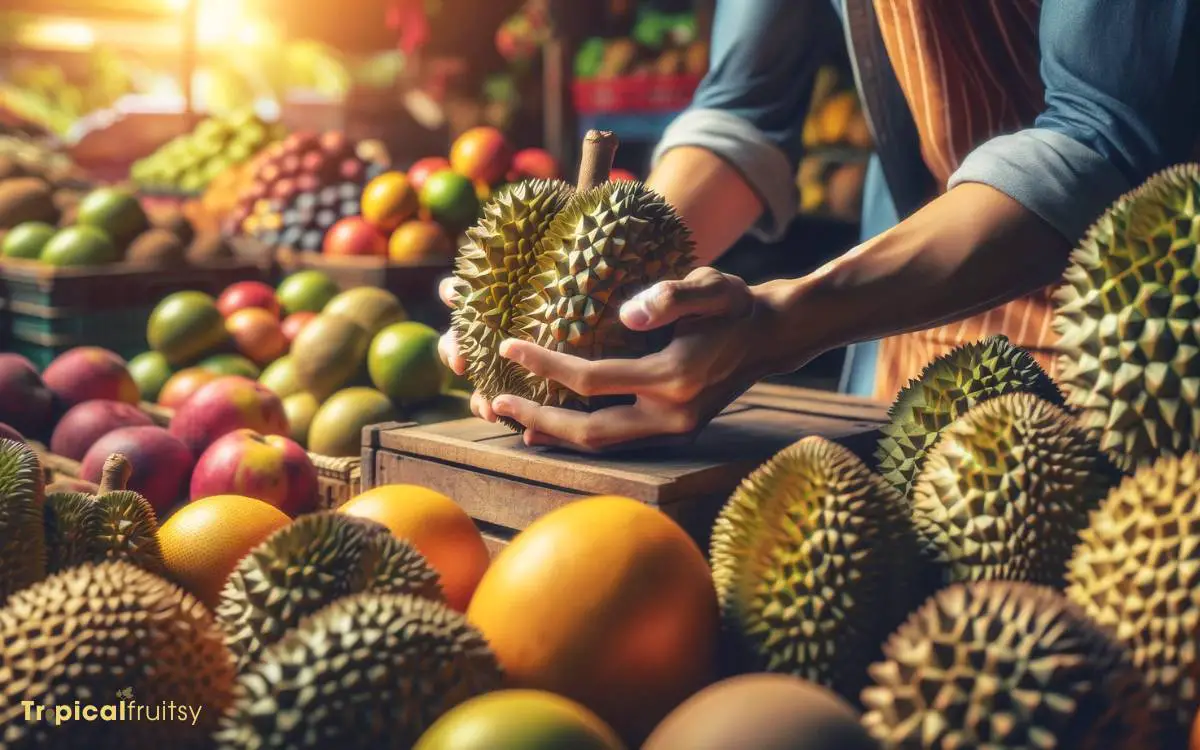
Choose a mature durian with firm spikes and a strong aromatic scent as the foundation for flavorful durian chips. The selection process is critical, as the fruit’s maturity directly influences the taste and texture of the final product.
Opt for specimens that exhibit a pronounced, sweet fragrance, indicating a high level of ripeness and an optimal concentration of natural sugars.
The spikes should be stout and resilient, ensuring that the fruit has not been compromised by external pressures, which could affect the internal integrity.
The durian’s husk color should be a consistent golden hue, free from any green undertones, which can denote under-ripeness.
With the ideal durian selected, the focus shifts to meticulous preparation, ensuring the transformation into high-quality chips.
Step 2: Preparing the Durian
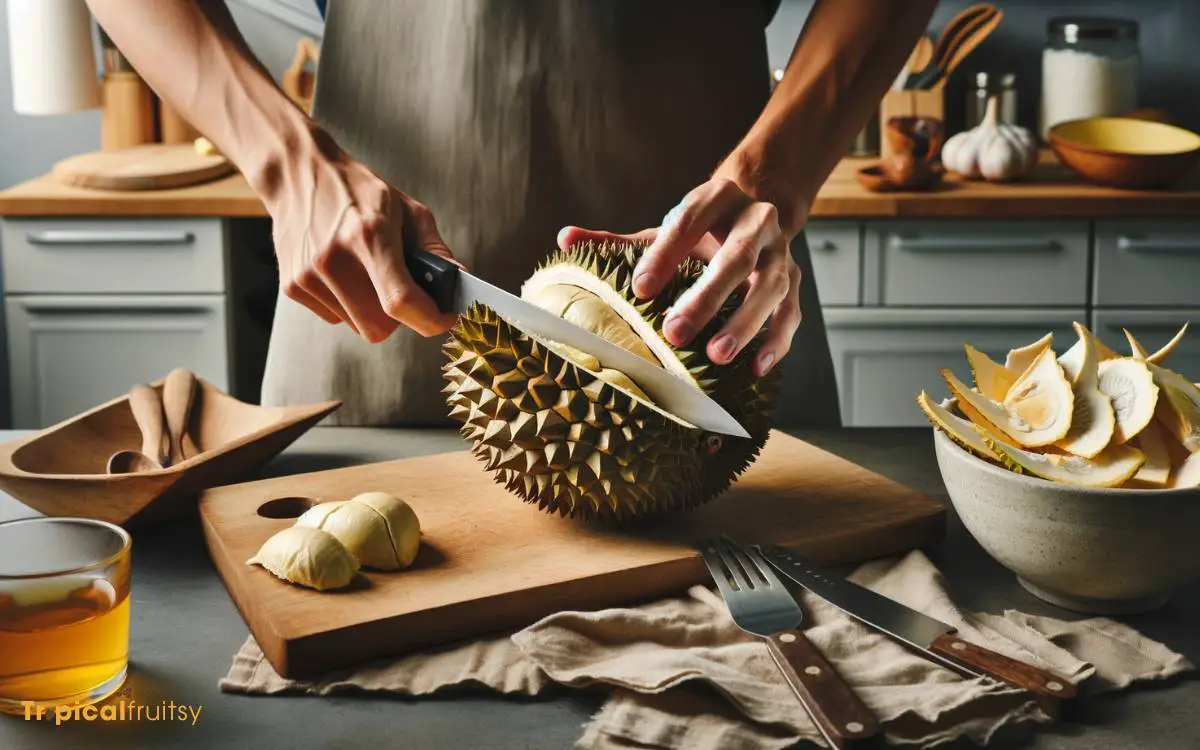
Preparing the durian for dehydration involves several steps. First, the fruit needs to be cleaned thoroughly to remove any surface contaminants.
Then, the formidable husk of the durian must be carefully removed to access the edible flesh. Once the flesh is exposed, it needs to be sliced into even, thin pieces that are suitable for chip-making.
This step requires attention to detail to ensure uniform drying and optimal texture in the final product.
To summarize, the essential steps for preparing the durian for dehydration are as follows:
- Sanitization: Thoroughly wash the durian to eliminate any surface contaminants.
- Decortication: Carefully extract the edible flesh from the spiky outer shell.
- Segmentation: Divide the durian flesh into uniform slices, aiming for consistency in thickness.
- Inspection: Examine each slice for imperfections, removing any discolored or bruised sections.
- Arrangement: Strategically place the slices on the dehydrator tray, ensuring ample space for air circulation.
These preparative measures are foundational to the success of the ensuing dehydration process.
Step 3: Slicing the Fruit
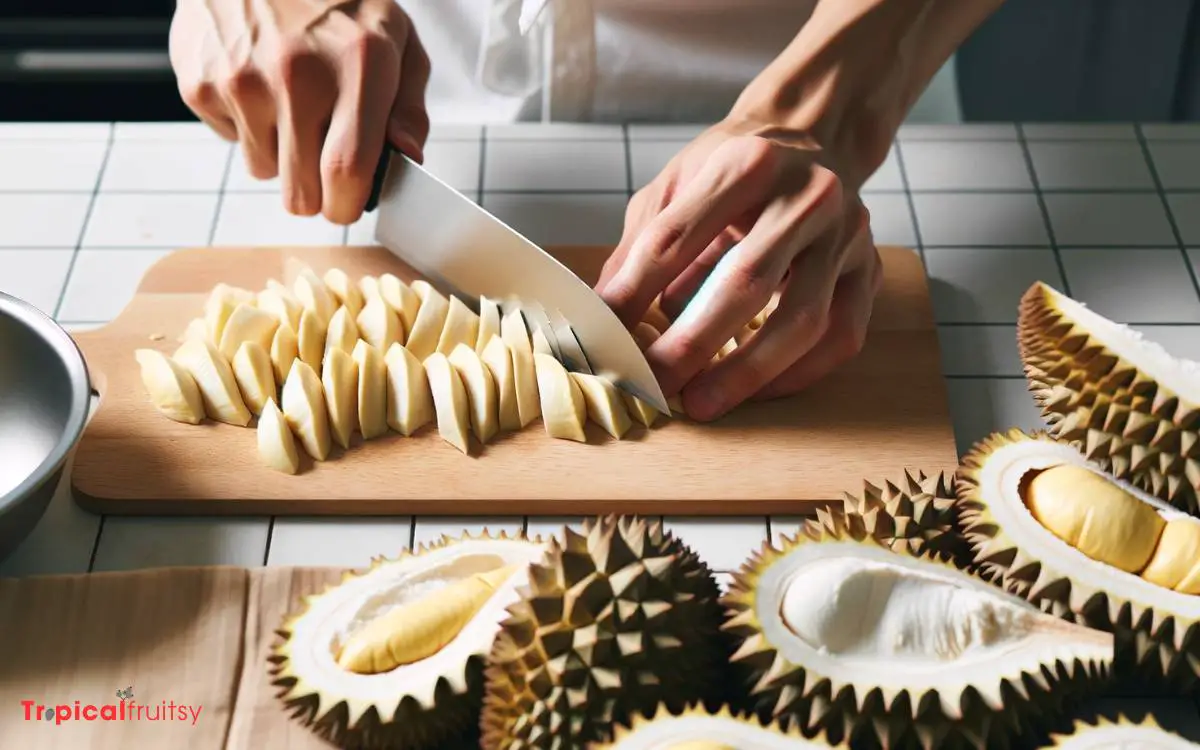
The segmentation of the durian flesh into even slices is a critical step to ensure uniform drying and high-quality chips.
Precise control over the thickness of each slice is paramount to facilitate even dehydration, which in turn contributes to the consistency of the final product’s texture and taste.
A mandoline or a sharp knife may be employed for this task, with the former providing a more consistent thickness.
| Thickness | Drying Time | Texture Outcome |
|---|---|---|
| Thin | Shorter | Crispier |
| Medium | Moderate | Balanced |
| Thick | Longer | Chewier |
For optimal results, a thickness of approximately 3-5 millimeters is recommended. This dimension is a critical determinant of the drying time and the resulting texture of the chips.
Uniformity in slicing not only ensures an even drying process but also a professional-grade product with a satisfying crunch.
Step 4: Blanching Durian Slices

Prior to dehydrating, blanching durian slices in hot water for a few minutes is essential to inactivate enzymes that can lead to spoilage and to preserve the fruit’s vibrant color.
The process involves a calculated immersion of the durian slices into boiling water, followed by an immediate transfer to an ice water bath to halt the cooking process.
This method not only ensures the deactivation of enzymes but also cleanses the slices, removing any surface impurities.
- Ensures longevity by halting enzymatic reactions that can degrade quality.
- Locks in the bright, natural hue of durian, enhancing visual appeal.
- Eliminates microorganisms that may affect flavor and safety.
- Improves texture, creating a more consistent chip.
- Prepares the fruit for optimal drying, resulting in a superior crunch.
Step 5: Drying the Slices

Following the blanching process, the uniform drying of durian slices is critical for achieving the desired crispness and quality in the final product.
The thickness of the slices directly influences the drying time and temperature required; hence, maintaining consistency is paramount.
Careful calibration of the drying environment, including the optimal temperature setting, and ensuring proper airflow with periodic flipping of slices, are essential parameters to obtain evenly dried durian chips.
Slice Thickness Consistency
Ensuring each durian slice maintains a uniform thickness of approximately 2-3 millimeters is crucial for consistent drying and texture in the final chips.
Variations in slice thickness can lead to uneven drying, which may result in a subpar gastronomic experience.
To achieve uniformity:
- Use a mandoline slicer for precision and consistency.
- Verify thickness with a calibrated measuring tool.
- Discard slices that deviate significantly from the desired range.
- Reposition slices midway through drying to promote even moisture evaporation.
- Monitor drying progress meticulously to prevent over-drying.
This meticulous approach to slice thickness will directly influence the drying process’s efficacy, ensuring that each chip offers the same satisfying crunch.
Optimal Drying Temperature
Slice uniformity achieved, the subsequent step in crafting durian chips is to select an optimal drying temperature, typically between 50°C to 70°C, to facilitate even dehydration without compromising the fruit’s flavor profile.
This range is critical; temperatures below 50°C may result in excess moisture retention, leading to microbial growth and potential spoilage.
Conversely, exceeding 70°C could cause undesirable caramelization of sugars and a loss of volatile compounds that contribute to the durian’s distinctive taste.
The drying curve must plateau at a point where the moisture content is sufficiently reduced to ensure crispness while retaining the fruit’s aromatic essence.
Careful monitoring of the temperature is imperative, with adjustments being made to maintain thermal conditions conducive to producing a high-quality, shelf-stable product.
Airflow and Flipping Slices
Effective dehydration of durian slices necessitates consistent airflow within the dehydrator to remove moisture uniformly and prevent uneven drying.
Airflow is a critical factor that influences the rate of drying and the ultimate quality of the durian chips.
Flipping the slices periodically ensures that all surfaces are exposed to the air, promoting even dehydration. This process should be approached with methodical precision.
- Ensures comprehensive moisture evaporation from each slice.
- Prevents the development of moist spots, which can lead to spoilage.
- Facilitates a consistent drying rate across all slices.
- Reduces the risk of case hardening, where the exterior dries too quickly, trapping moisture inside.
- Contributes to a uniform texture and crispness in the final product.
This meticulous attention to airflow and flipping is essential for crafting premium-quality durian chips that are evenly dried and possess a satisfying crunch.
Step 6: Seasoning Your Chips
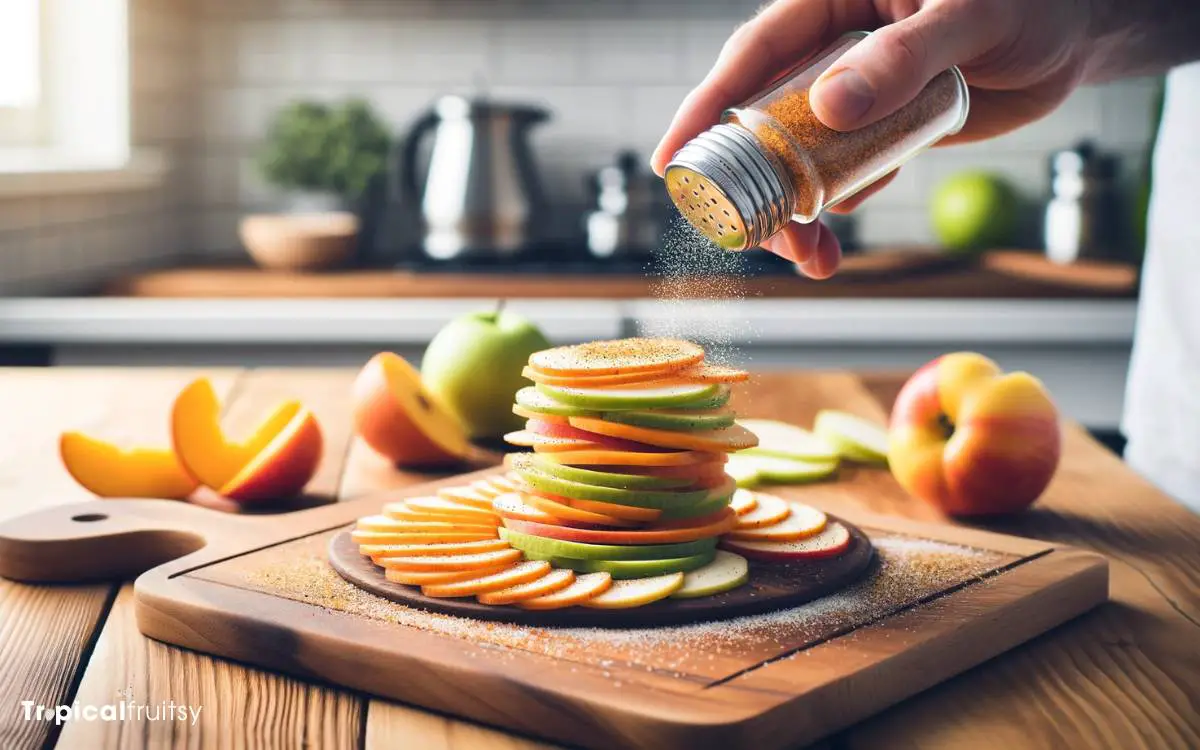
Upon reaching the seasoning phase, the selection of an appropriate spice blend is critical, as it must complement the unique taste profile of durian.
A meticulous consideration of the balance between sweet and savory can enhance the chip’s appeal, catering to diverse palates.
Moreover, the equilibrium of salt intensity is essential to underscore the chips’ flavor without overwhelming the durian’s natural essence.
Spice Blend Choices
In the context of flavor enhancement, selecting an appropriate spice blend can significantly elevate the taste profile of your durian chips. The complex flavor of durian can be complemented by a myriad of seasonings.
When choosing spices, consider the following:
- Cinnamon: Offers a warm, sweet note that contrasts the durian’s inherent savoriness.
- Nutmeg: Contributes a nutty, slightly sweet flavor with hints of woody spice.
- Sea Salt: Enhances the natural flavors and adds a crisp, savory edge.
- Chili Powder: Introduces a spicy kick that can balance the fruit’s richness.
- Lemon Zest: Provides a citrusy tang that can cut through the creamy texture.
Each spice should be used judiciously to avoid overpowering the durian’s unique taste.
Sweet Vs Savory
Moving from the selection of individual spices to the broader culinary strategy, the choice between sweet and savory seasonings can profoundly influence the final character of your durian chips.
Opting for sweet seasonings often entails incorporating sugars or syrups, cinnamon, vanilla extract, or even fruit powders, which complement the durian’s natural sweetness and can enhance its complex flavor profile.
Conversely, savory seasonings may involve the use of salt, herbs such as rosemary or thyme, garlic powder, and various forms of pepper, which are designed to contrast with the durian’s sweetness and add a depth of flavor that is umami-rich and palate-stimulating.
The determination of the seasoning route hinges on desired taste outcomes, which should be informed by an understanding of flavor balance and the target consumer palate.
Salt Level Balance
Achieving the perfect salt level balance is crucial in enhancing the durian chips’ flavor without overpowering the fruit’s natural taste nuances.
The process of seasoning should be approached with a methodical and analytical mindset, taking into account the unique properties of durian.
Here are some technical considerations for seasoning:
- Gradually add salt, tasting intermittently to prevent over-saturation.
- Utilize a precision scale to measure salt to the nearest gram for consistent results.
- Consider the moisture content of the durian, as it affects salt absorption.
- Factor in the reduction of volume post-dehydration, which can intensify flavors.
- Take note of the variance in salt crystal size and its impact on solubility and taste perception.
Step 7: Baking or Frying

Durian chips can be prepared using two primary methods: baking or frying, each offering a distinct texture and flavor profile to the final product.
The baking process involves dehydrating the sliced durian in an oven at a low temperature over an extended period. This results in a crisp texture with a more muted, sweet, and fruity flavor due to the gradual evaporation of moisture.
Conversely, frying entails immersing the durian slices in hot oil. This achieves a quicker moisture extraction and thus, a richer, more intense flavor with a crunchier bite.
The choice of method not only influences the sensory attributes but also impacts the nutritional content. Baking generally yields a lower fat product compared to frying.
Step 8: Storing Durian Chips
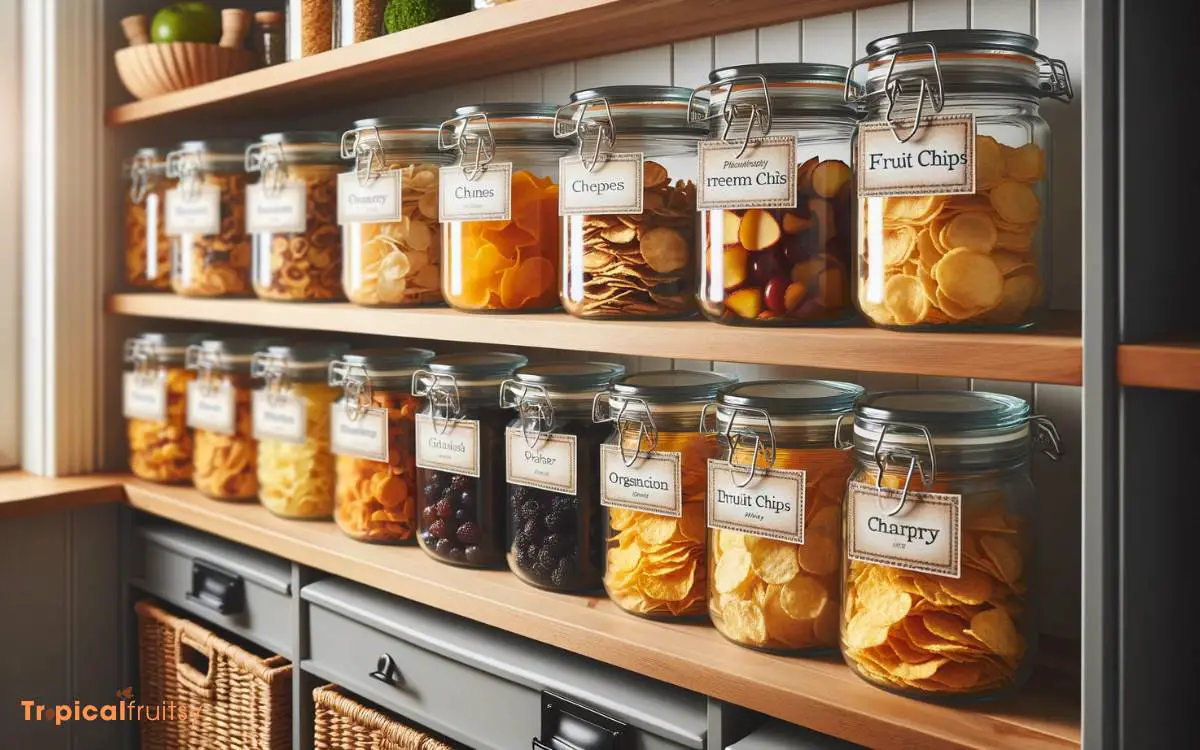
Once prepared, whether baked or fried, durian chips must be stored properly to maintain their freshness and crispness.
The storage environment must thwart moisture reabsorption and prevent aroma degradation, factors which are detrimental to the product’s sensory properties.
Implementing the correct storage methodology is crucial for extending the shelf life of durian chips and preserving their quality.
- Store in an airtight container to prevent exposure to ambient humidity.
- Ensure the container is made from non-reactive materials to avoid flavor alteration.
- Keep the container in a cool, dry place away from direct sunlight to minimize lipid oxidation.
- Consider using desiccants like silica gel packets to absorb excess moisture.
- Periodically check for signs of spoilage or staleness to maintain quality control.
These steps are imperative for an optimal storage solution that maintains the durian chips’ desirable texture and taste.
Conclusion
The transformation of the pungent, creamy durian into crisp, delectable chips is a meticulous process that culminates in a unique culinary delight.
Through careful selection, precise preparation, and exacting drying techniques, the durian’s inherent flavors are concentrated and transformed.
The resulting chips offer a textural contrast and an intensity of taste that challenge the palate, promising an exotic snack experience that lingers, both in memory and taste, long after the last bite.






